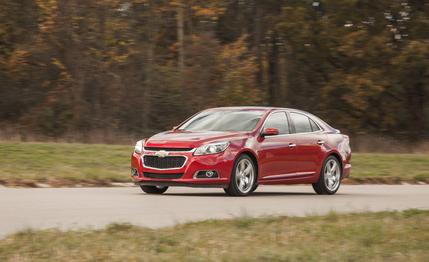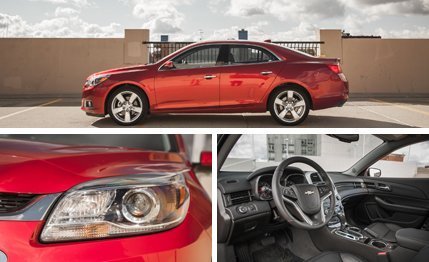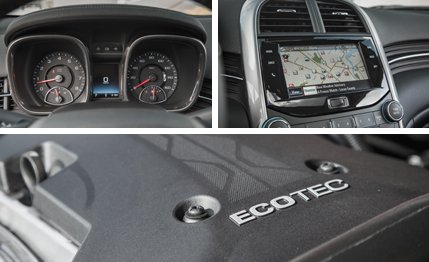
 Instrumented Test
TESTED
Instrumented Test
TESTED
A pseudo trend is unfolding among new models that have been introduced to middling success: They’re being quickly returned to their respective senders for quick-fire updates. Honda recently bucked industry practice by reconstituting its 2012 Civic sedan for 2013—and the coupe for 2014—well short of the typical three-year mid-cycle-refresh protocol. Chevrolet found itself in the plastic surgery clinic after the 2013 Malibu was met with flagging sales and a “meh” from the critical press, C/D included. And so the company rejiggered the sedan just one year later. To assess the effectiveness of the changes for 2014, we got our hands on an uplevel LTZ turbo model for a test.
More Torque and, Uh…
All 2014 Malibus wear a new Impala-like front fascia and receive tweaks to the suspension and electric power steering. In contrast to the base four-cylinder 2.5 model, which adds intake-valve lift control and a standard stop-start system (the Eco hybrid model has been killed, for now), the turbo’s 2.0-liter four gets only a software update, albeit one good for an additional 35 lb-ft of torque. This brings peak twist to 295 lb-ft, while max output holds at 259 horsepower. A six-speed automatic remains the sole transmission choice, and as in last year’s Malibu, a rocker switch on the shift lever affords a very unsatisfying mode of manual gear selection.


The turbo’s software tweak paid off in our testing, with our equipment recording more spritely acceleration to 60 mph (6.2 seconds, 0.1 second quicker than last year’s) and through the quarter-mile (14.8 seconds at 97 mph, improvements of 0.2 second and 2 mph). Top speed stretches, too, by 10 mph to an impressive 155. Even so, the turbo Malibu retains the 2013 model’s penchant for torque steer, its transmission still bent on staying in the highest gear possible before occasionally flubbing hurried downshifts, and the car remains numb to subtle part-throttle inputs at highway speeds when the engine’s out of boost.
In the chassis department, the sporty promise of the turbo’s red badge is again let down by the ’Bu’s comfort-tuned ride and preference for straight-line cruising. Suspension updates trickling down from the larger Impala, such as roll-attenuating rebound springs in the struts, really apply more to the base 2014 2.5 model; the turbo already had most of those upgrades and thus feels pretty much the same as before. Supposedly tuned for less boost and more road feel, the Malibu’s electrically assisted steering exhibits only the subtlest increase in effort, and feedback from the front tires remains almost entirely absent. The turbo does, however, still excel at braking, stopping from 70 mph in 168 feet, just three feet longer than last year’s car.


A Nose Job but Not Much Else
Despite Chevy’s impressively quick face lift on this Malibu, we simply don’t think there are enough other substantive improvements to draw in hordes of new buyers. (We’ll reserve judgment on the base model until we test one.) The back seat is still too cramped, in spite of the newly scooped-out front seatbacks that give rear passengers slightly more kneeroom. The clashing colors, textures, and materials in the cabin give us a headache. The standard and optional equipment lists mirror those from last year, too.
We had wondered whether this refresh might mitigate the Malibu’s wallflower status, but the Chevy still doesn’t wow like the Honda Accord, Mazda 6, Ford Fusion, and Volkswagen Passat—all of which offer more character and driving satisfaction. Had the turbocharged Malibu incorporated the base car’s engine stop-start system, at least it would have a relatively unique feature to attract buyers. Without it, EPA estimated fuel economy stays unchanged at 21 mpg city and 30 highway. We tallied the same 23 mpg during our test as we did in last year’s car. Perhaps worrisome for Chevrolet is that the turbo shares showroom space with the roomier, better-looking, and similarly priced V-6–powered 2014 Impala. The latter is the Chevy we’d choose, and we doubt the brand intended to conquest sales from itself. That’s a problem that will require more than a mild refresh to fix.